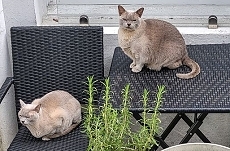Adam Yamey's Blog: YAMEY, page 91
April 22, 2023
It need not have happened
CONSTRUCTED IN 1974, it was 221 feet tall. It overshadowed the homes of many people including many of the wealthier inhabitants of West London’s Kensington. And I imagine that the wealthy inhabitants of the elegant crescents and other thoroughfares near it did not appreciate the views from their windows being spoiled by this Brutalist block of flats containing less well-off people, about whom they would rather not think. Between 2015 and 2016, the block was refurbished and made less of an eyesore by the addition of cladding – ostensibly to improve insulation – to its exterior.
On the afternoon of the 13th of June 2017, I was walking around North Kensington, taking photographs as usual. I stopped to take pictures of the recently built Kensington Leisure Centre and its near neighbour the Kensington Aldridge Academy – both are interesting examples of contemporary architecture. While I was taking these photos, I had my back to the tower block I have just described. Had I looked at it then, I would have thought that it would have been of little interest to me. How wrong I was.
Just after midnight on the following day, a fire broke out in that tall block – Grenfell Tower – that edifice which overlooked the homes of the wealthy residents of Kensington. The fire spread rapidly because of the highly inflammable nature of the cladding used to make the tower more attractive to its neighbours. Seventy-two people died in the conflagration; many were injured; and all the surviving residents were not only badly scarred psychologically, but also lost their homes and possessions.
From wherever you looked in a large area around Grenfell, including from the homes of the prosperous residents of Holland Park and Notting Hill, one could see the horrifically charred tower block – a fear-inspiring eyesore – the result of local government officialdom ignoring repeated warnings about the already known potential fire hazards that the cladding presented and inadequate planning for escape during a fire. I felt – and I am not alone in thinking this – that the local council hardly cared for a few impecunious residents in a tower block. What was more important was to save money so as not to impose high local taxes on people who could have easily afforded to pay them.
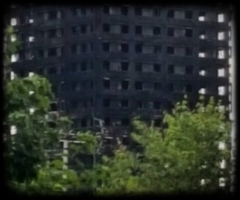
Soon after the fire, the charred tower was covered with protective wrapping to assist forensic investigations and to contain debris, which might otherwise have flown away and dropped in the neighbourhood. It also removed from sight the scarred, charred remains of the building – a 24 hour a day reminder of the avoidable, tragic loss of life, which was not altogether disconnected with civic and possibly criminal negligence. The remains of the tower are still covered up. Before the heart-rending remains of the conflagration were covered up, filmmaker Steve McQueen (born 1969 not far from Grenfell Tower) made a short film about the tower. It is currently on show at the Serpentine South Gallery in Hyde Park until the 10th of May.
The film is without words in its soundtrack and without any captions. It looks as if it might have been filmed with a drone or a camera held within a helicopter. It begins with a flight over beautiful countryside far beyond the edge of London. The camera moves above the scenes of rural serenity and slowly the city of London comes into view. We pass over London’s sprawling suburbs, and then the charred Grenfell Tower begins to be seen in the centre of the screen. The camera moves closer and closer to the blackened building, and then slowly circles around it many times. Each time the tower is slowly encircled, and the camera moves closer to it, more and more details of the destruction entered my consciousness, and my understanding of the horror of what had befallen Grenfell and its inhabitants gradually increased. As the camera moved around the wreck, you could catch glimpses of the parts of London surrounding it – the houses and flats of those who must have witnessed the fire, but were not affected by it, at least not physically. As the camera moved, one could see trains moving on nearby tracks and vehicles travelling along roads. I felt that I was witnessing life going on as usual at the same time as witnessing the horrors of a disaster. The absence of commentary added to the powerful impact that seeing these images of a lethal incineration simultaneously with scenes of normality made on me. There was a soundtrack, which consisted of recordings of everyday sounds – both natural and man-made. However, while the camera encircled the tower of death, there was no sound at all. I wondered whether this signified the fact that the victims, who had died, will no longer be able to enjoy the sounds of everyday life.
McQueen’s film is a sophisticated and solemn memorial to an event that could easily have been avoided. Without a soundtrack or explanations, the viewer is left to ponder the tragedy in his or her own way.
April 21, 2023
You could become a police officer
IN OCTOBER 1970, nine young people, including me, assembled in a room at University College in London’s Gower Street. It was the first day of our three-year course that would end with us being awarded Batchelor’s degrees in mammalian physiology. During the first year, we studied basic sciences and mathematics and had sparingly little to do with the Physiology Department. However, once a week someone from the department gave us a tutorial during which a variety of subjects were discussed. Often, these were conducted by an amiable lecturer, Jim Pascoe, a Cornishman with a strong Cornish accent.
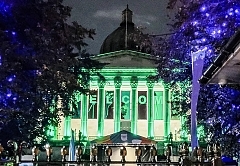
During one of these sessions, one of us, Jenny, asked Mr Pascoe:
“What can we do with this degree?”
Pascoe thought for a minute, and said in all seriousness:
“You could become a policeman.”
What he said was not as frivolous as it sounded. With the exception of some professional training first degrees, such as medicine, dentistry, veterinary science, law, and architecture, most first degrees are essentially brain training courses. Good first degrees can lead their holders anywhere. They leave university with enhanced intellectual development and, maybe, a few other life skills. What Jim Pascoe said was a good answer.
So, what happened to the nine of us who first met each other in a room near Gower Street one morning in October 1970? One of us, a man, dropped out after one year. Four of us became academics. The last I heard of Janet was that she was working towards a PhD in goldfish behaviour. Allegra, probably the brightest person on our course, became a practitioner of acupuncture. Lopa, who is now my wife, became a banker, then a barrister. I became a practising dentist. And Jenny did not become a police officer – she qualified as a medical doctor.
April 20, 2023
A bigger pool
IN COMMON WITH most people, I have little or no memory of the first two or three years of my life. My earliest recollections are the birth of my sibling when I was four years old, and walking with my parents to St Albans Church Hall in Golders Green to collect the free orange juice that the government provided in the 1950s. That was issued to children under the age of two, so it must have been for my sibling within the first two years of her life. At that time, I would have been less than six years old.
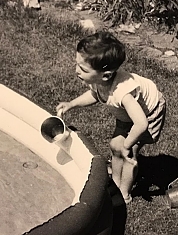
Recently, a cousin sent me scans of some family photographs. They include several of me before I was four years old. One of them taken of me in our garden in Hampstead Garden Suburb shows me standing beside a circular inflatable swimming pool filled with water. In the photograph, I am bending over the pool with a small jug in my right hand. None of this can I recall, except the crazy paving garden path behind me, which remained in existence until the 1990s, and might well still be there.
Seeing the photograph, which must have been taken before 1956, did jog my memory. I recall that after my sibling was born, my parents bought a bigger paddling pool for use in our garden. This was a rectangular affair. It consisted of a metal framework that had to be assembled and a plastic pool that was hung from its four sides before being filled with the garden hose. At each corner there was a small triangular metal seat. Well, I doubt I would have remembered this had I not seen the image of something I cannot remember at all.
April 19, 2023
Kensington cats
April 18, 2023
A cup of coffee
Somnath in the state of Gujarat is one of India’s important Hindu pilgrimage centres. People flock to the small town to worship in the Somnath Temple (also known as the ‘Deo Patan’). The shrine has been in existence for many centuries, but was demolished by Muslim invaders several times, and re-built after each episode of demolition. The structure you see today was built in the early 1950s.
To enter the temple, one must first divest yourself of cameras, all electronic equipment, and anything made with leather – remember, the cow is sacred in Hinduism. Although we did not enter the crowded temple because of the long queue, we watched the line of people waiting to file through the security check point at the temple compound’s entrance. Everyone passed beneath a metal detector archway and then was frisked. But it was a frisking with a difference. The security personnel passed their hands up and down, and close to, each of the visitor’s bodies, but made no physical contact with them.

Far less visited than the temple, but close by, there is a fascinating museum containing artefacts – sculptures and architectural fragments. All of the exhibits had once been parts of the former Somnath temples, which had been destroyed. Part of the collection was housed in a building constructed with domes and pillars from the former reincarnations of the temples.
After viewing the museum on a warm morning in March 2018, we were ready for a drink. It was around 11 am and coffee would have been very welcome, but our chances of finding some were pretty slim because we had discovered that in most of Gujarat coffee is not available in outlets providing drinks. As we walked away from the museum, a lady, hearing us speaking in English, stopped us in the street, and told us that she was a retired English language teacher. Kindly, she asked us to come into her home, next to which we were standing, to join her for a cup of – we could hardly believe what we were hearing – coffee. Full of anticipation, we followed her indoors. She told us that she drank coffee all day.
Our hostess fetched two disposable cups and filled them with hot milk to which she added a few grains of instant coffee powder. She seated us in her living room, and soon we were joined by another lady, who had just dropped in to say hello. At about the same time, some (wild) street dogs also entered the house, and our hostess fed them biscuits. Now, I do not want to sound ungrateful, but it was difficult even to imagine that we were drinking coffee because the amount of coffee she had added to the milk was so little; it was homeopathic in quantity.
After a while, our hostess’s husband arrived home and joined us. A retired businessman, he had become a pandit (a Hindu priest). As with many people we had already met during our travels in Gujarat, the first question he asked my wife was about her caste. In her case, that is not a simple question to answer because her parents, who did not believe in the importance of the caste system, were not from the same caste. In fact, my wife had no idea of what her caste until she was 27 years old. One of them was a Kayasth. The pandit explained that the Kayasths are offshoots of the Brahmins, but essentially Brahmin. Later, we spoke about the temples in Somnath. He was attached not to the main pilgrimage temple but to a smaller one nearby, which is much older than the Deo Patan. We had visited it earlier in the day. Kindly, he walked with us through the town, helping us find our way back to our hotel, which was near the town’s quite grand railway station.
Although the coffee was not quite what we were hoping for, the disposable cups deserve more of a mention. The Pandit’s wife cannot have been sure of our castes and was too polite to ask. Well, I do not qualify for any reference to the caste system, and she had not asked my wife about her caste, or even whether she is a Hindu. As a devout Hindu, and a pandit’s wife, she could not risk her coffee cups becoming polluted by being touched by people who were not, or might not be, of the right caste. For safety’s sake, she used the cups that could be disposed of after we had touched them.
April 17, 2023
A female pioneer of artistic photography
Many people will have heard of at least one of the following: Alfred Lord Tennyson, Charles Darwin, Anthony Trollope, Charles Dodgson (Lewis Carroll), Edward Lear, Henry Wadsworth Longfellow, Virginia Woolf, Vanessa Bell, and William Dalrymple.
Fewer might be familiar with George Frederic Watts, Valentine Prinsep, Julia Stephen, and Dejazmatch Alamayou Tewodros.
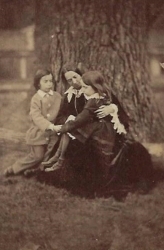
One thing that all of the people listed above share is that they were in diverse ways connected with a Victorian pioneer of artistic photography – Julia Margaret Cameron (1815-1879).
To discover about this fascinating woman and how her story involves all of the above-mentioned, please read “BETWEEN TWO ISLANDS: JULIA MARGARET CAMERON AND HER CIRCLE” by Adam Yamey. It is available both as a paperback and as an e-book from Amazon:
April 16, 2023
In a lovely garden
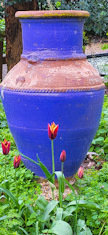
Tulips and a jar
In a Moroccan garden
Soothe my weary eyes
April 15, 2023
Ethiopian coffee under the railway tracks
IT WAS FROM ETHIOPIA that historians believe coffee beans were first exported to Yemen, where they were roasted and processed into what we would now recognise as a coffee drink. The earliest recorded use of coffee beans for brewing the drink was in 15th century Yemen. However, soon the drink spread to other parts of the Middle East, North Africa, Turkey, and Persia. By 1600, it had reached Europe. Today, the 13th of April 2023, we were strolling along Shepherds Bush Market, which runs alongside the elevated railway tracks along which trains of the Hammersmith & City and Circle Lines run. The tracks run high above the market supported by brickwork arches. Some of these arches have been used to house shops and in one case an interesting café, which opened in 2020, just before the first of the covid19 lockdowns.
The café is called Delina and is run by Ethiopians. Beautifully decorated with Ethiopian textiles and other artworks, this place offers Ethiopian fare including coffee from Ethiopia. Customers can have their coffee prepared in various common ways such as, for example, Americano, espresso, and latte. I asked whether I could try coffee the way it is drunk in Ethiopia and was given the choice of coffee flavoured with cardamom or with ginger. I opted for the latter because once, many years ago, I had drunk coffee with ginger (and other spices) in a tiny coffee shop next to a mosque in Fort Kochi (Kerala, India), and liked it.
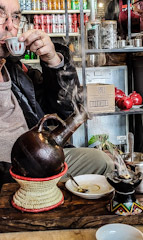
The lady working behind the bar first collected a ‘jebena’, which is ceramic container with a cylindrical base, a handle, and a long neck with a pouring spout. She washed it out and then placed it on a glowing charcoal to both dry it and heat it. Meanwhile, she prepared some coffee in the espresso machine, and filled a small jug with it. To this she added some ginger powder and stirred the mixture well. Carefully, she poured the ginger coffee into the heated ceramic container. Then, she loaded a small tray with the following: the ceramic container and a woven stand to support it upright; a tiny coffee cup with no handle; a bowl of sugar; and a small circular holder containing lumps of smoking incense. She explained that in Ethiopia it was believed that drinking coffee whilst being bathed in incense fumes enhanced the enjoyment of the beverage. There was enough coffee in the jug to refill the tiny cup or bowl about five times.
In Ethiopia, the coffee is usually first roasted in front of those who are about to enjoy it, ground with a pestle and mortar, and then brewed with water in the jebena being heated on charcoal. Then, it is poured into the tiny cups through a filter made with fine filaments. Although Delina has an electrically heated pan for roasting coffee beans, I imagine that roasting a fresh batch for one customer was considered too much work. I can imagine that when the place has a group of Ethiopian customers, shortcuts cannot be taken and the beans are freshly roasted for them.
As for the coffee laced with ginger, it was enjoyable. I could not taste the ginger, but I could feel it in my throat as I swallowed it. Years ago in Fort Kochi, we had been told that it was believed that ginger coffee was beneficial for the throat. Would I go to Delina again? Yes, I would. Despite the trains rumbling overhead every few minutes, the place has a delightful and visually satisfying ambience, and friendly staff. It also serves Ethiopian food, which we have yet to sample.
April 14, 2023
A versatile contemporary artist
YESTERDAY, WE ADMIRED paintings created by the Great Masters of European art, which hang on the walls of the rooms of 18th century Kenwood House in north London. Today, the 12th of April 2023, we enjoyed artworks of a completely different nature within the almost spartan spaces of the White Cube Gallery in Bermondsey Street. Currently, three artists’ works are on display. Three areas in the gallery are dedicated to one of them – Marguerite Humeau. She was born in 1986 in France, and received her MA from the Royal College of Art in London – the city in which she now lives and works.
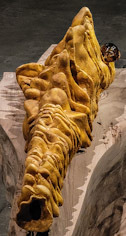
Humeau creates works in a wide variety of materials. She also makes video art, one example of which was on show in the smallest of the three spaces. A larger room contained panels made with one or more ceramic tiles. The glazed surfaces of these tiles are not flat but contain hand-sculpted three-dimensional features including textural variations and curvy striations, which protrude from the flattish background surface.
The largest room of the show must be seen to believed. Entering is like setting foot on an alien planet inhabited by weird organic shapes that suggested to me plants, fungi, and insects, but all of them greatly magnified. These shapes are sculptures created by Humeau. Some of them were emitting musical sounds. I found the sculptures both intriguing because of their allusions to biological structures and also quite satisfying visually. As to what led to their creation, the gallery’s website (https://whitecube.com/artists/artist/Marguerite_Humeau) explained:
“The artist was inspired by eusocial insects such as ants, termites and bees, whose complex cooperative societies enable them to build huge structures and to cultivate other organisms in symbiotic relationships. Reflecting on the ants shepherding their aphids and the termites tending their fungus gardens, Humeau found an equivalent in the place yeast has assumed in human societies, as the essential ingredient of bread and beer around which our human collective has gathered. Contemplating the probability of our imminent, self-inflicted extinction as a species, Humeau sees insect societies as both the inheritors of our ravaged environment, and a prompt to consider how interdependence and cooperation might offer a means to avert our fate.”
Fair enough; but even if the works are portents of a gloomy future, my spirits were uplifted by seeing them. The exhibition continues until the 14th of May 2023. If you plan to visit it, save a bit of time for the interesting and attractive, abstract paintings and sculptures by Samuel Ross (born 1991 in London), which are on show in another of the gallery’s spaces.
The thing that amazes me is that even though the paintings by the Great Masters, who painted many centuries ago and which we saw 24 hours ago at Kenwood are immensely satisfying visually, seeing the artworks by Marguerite Humeau today was an equally enjoyable experience. I wonder what it is that happens in the brain to produce the same amount of enjoyment from seeing such widely differing artistic creations.
April 13, 2023
Caught in the act midair
TO CAPTURE A DETAILED IMAGE of a hawk attacking a bird in mid-air using photography would require a decent camera with a good lens and a high shutter speed. Yet, in about 1832 – long before cameras with high shutter speeds existed – the painter Edward Landseer (1802-1873) depicted a hawk attacking another bird high above the ground. He did not use photography. He created his picture on canvas with his paintbrushes and oil paints. His painting, “Hawking in the Olden Time”, hand in north London’s Kenwood House where I saw it today, the 11th of April 2023.
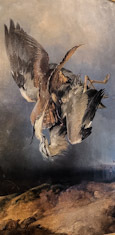
Clearly, Landseer’s image is a painting, but it contains as much detail as a reasonably good photograph. It must have taken him very much longer to execute than the fraction of a second that the event – the attack, which he captured on canvas, lasted in real life. Was his visual memory so good that he was able to hold a detailed memory of that instant in his head whilst he painted it? Although I doubt it, that possibility cannot be ruled out.
As I stood in front of the picture, pondering about it, another theory entered my head. During the nineteenth century, the art of taxidermy had reached a high degree of development. For example, the British ornithologist John Hancock (1808-1890) was an accomplished taxidermist. One of his works, “The Struggle with the Quarry”, which is in the Hancock Museum (in Newcastle upon Tyne) consists of one stuffed bird attacking another, and at first glance makes one think of Landseer’s painting. Although this was created after Landseer made his painting, the art of taxidermy had already begun to be perfected by taxidermists such as Louis Dufresne (1752-1832). So, when I was standing in front of the painting at Kenwood and thinking that Landseer might well have used a work of taxidermy as a model for his picture, I might not have been mistaken.
Kenwood House contains one of London’s best collections of old master paintings outside the city’s major public art galleries. Each time I visit it, I discover something that I had not noticed before. I am sure that I had seen the painting by Landseer, but it was not until today that I gave it more than a passing glance. Today, while walking around the house with some friends who had never been there before, we stopped in front of the painting of mid-air carnage and wondered how this image had been created before modern photography had been invented. Maybe, what I have written provides the answer.

